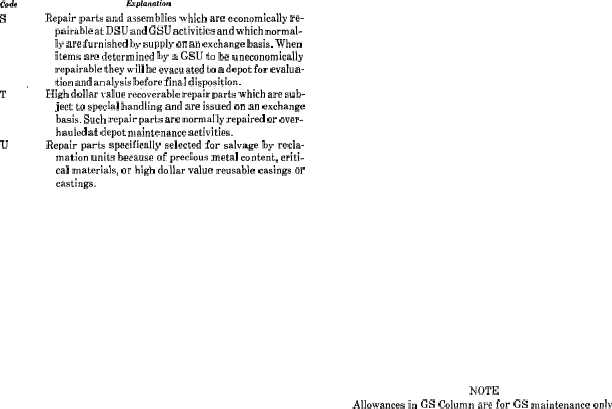code
Explanation
s
Repair parts and assemblies which are economically re-
pairable at DSU and GSU activities and which normal-
ly are furnished by supply on an exchange basis. When
items are determined by a GSU to be uneconomically
repairable they will be evacuated to a depot for evalua-
tion and analysis before final disposition.
T
High dollar value recoverable repair parts which are sub-
ject to special handling and are issued on an exchange
basis. Such repair parts are normally repaired or over-
hauled at depot maintenance activities.
u
Repair parts specifically selected for salvage by recla-
mation units because of precious metal content, criti-
cal materials, or high dollar value reusable casings or
castings.
b. Federal Stock Number. Indicates the Federal
stock number assigned to the item and will be used
for requisitioning purposes.
c. Description. Indicates the Federal item name
and any additional description of the item required.
Assembly components and subassemblies are in-
dented under major assemblies. The abbreviation
“w/e” when used as a part of the nomenclature, indi-
cates the Federal stock number includes all arma-
ment, equipment, accessories, and repair parts issued,
with the item. A part number or other reference
number is followed by the applicable 5-digit Federal
supply code for manufacturers in parenthesis. Re-
pair parts quantities included in kits and sets are
shown in front of the repair part name. Material re-
quired for manufacture or fabrication is identified.
d. Unit of Measure (U/M). A two-character alpha-
betic abbreviation indicating the amount or quantity
of the item upon which the allowances are based,
e.g., ft, ea, pr, etc.
e. Quantity Incorporated in Unit. Indicates the
quantity of the item used in the assembly group. A
“V” appearing in this column in lieu of a quantity
indicates that a definite quantity cannot be indi-
cated (e.g., shims, spacers, etc.).
f. Fifteen-Day Organizational Maintenance Allow-
ance.
(1) The allowance columns are divided into four
subcolumns. Indicated in each subcolumn opposite
the first appearance of each item is the total quantity
of the items authorized for the number of equip-
ments supported. Subsequent appearances of the
same item will have the letters “REF” in the allow-
ance column. To locate the referenced item, locate
the FSN or reference number in the index. The
earliest figure and item number is the referenced
item. Items authorized for use as required but not
for initial stockage are identified with an asterisk
in the allowance column.
(2) The quantitative allowance for organizational
level of maintenance represents one initial prescribed
load, for a 15-day period for the number of equip-
ments supported. Units authorized additional pre-
scribed loads, multiply the number of prescribed
loads by the quantity in the appropriate density col-
umn to determine the number of repair parts
authorized.
(3) To determine allowances when supporting
more than 100 of these equipments: First, divide the
number of equipments supported by 100 by moving
the decimal two spaces left; second, multiply the
result by the quantity in the 51-100 density column.
Example, authorized allowances for 51-100 equip-
ments is 12; for 140 equipments, multiply 12 by 1.40
or 16.80 rounded off to 17 parts required.
(4) Subsequent changes to allowances will be
limited as follows: No change in the range of items
is authorized. If additional items are considered
necessary, recommendation should be forwarded
to the U.S. Army Mobility Equipment Command for
exception or revision to the allowance list. Revisions
to the range of items authorized will be made by the
U.S. Army Mobility Equipment Command based
upon engineering experience, demand data, or
TAERS information.
g. Thirty-Day DS/GS Maintenance Allowances.
NOTE
Allowances in GS Column are for GS maintenance only.
(1) The allowance columns are divided into three
subcolumns. Indicated in each subcolumn, opposite
the first appearance of each item, is the total quantity
of items authorized for the number of equipments
supported. Subsequent appearances of the same item
will have the letters “REF” in the applicable allow-
ance column. To locate the referenced item locate the
FSN or reference number in the index. The earliest
figure and item number is the referenced item. Items
authorized for use as required but not for initial
stockage are identified with an asterisk in the allow-
ance column.
(2) The quantitative allowances for DS/GS levels
of maintenance will represent initial stockage for a
30-day period for the number of equipments sup-
ported.
(3) To determine allowances when supporting
more than 100 of these equipments: First, divide
the number of equipments supported by 100 by mov-
ing the decimal two places left; second, multiply the
result by the quantity in the 51-100 density column.
Example, authorized allowance for 51-100 equip-
ments is 40; for 150 equipments multiply 40 by 1.50
or 60 parts required.
h. One-Year Allowance Per 100 Equipments/Con-
tingency Planning Purposes. Indicates opposite the
first appearance of each item the total quantity re-
quired for distribution and contingency planning
purposes. The range of items indicates total quanti-
i v

